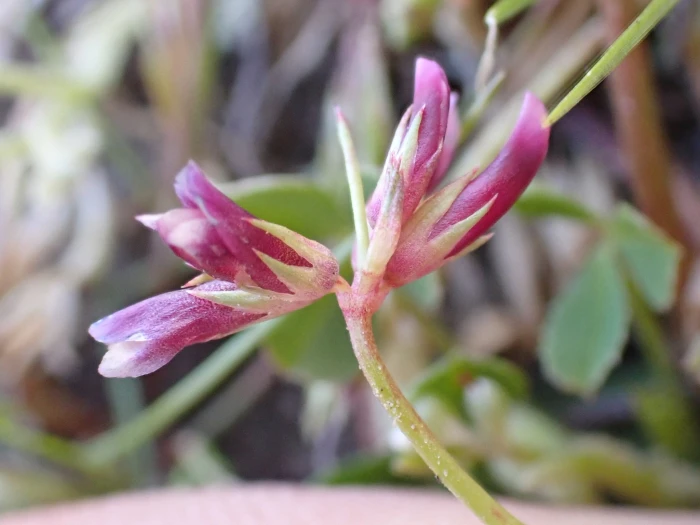Pinpoint Clover
(Trifolium gracilentum)
Pinpoint Clover (Trifolium gracilentum)
/
/

Chloe and Trevor Van Loon
CC BY 4.0
Image By:
Chloe and Trevor Van Loon
Recorded By:
Copyright:
CC BY 4.0
Copyright Notice:
Photo by: Chloe and Trevor Van Loon | License Type: CC BY 4.0 | License URL: http://creativecommons.org/licenses/by/4.0/ | Rights Holder: Chloe and Trevor Van Loon | Publisher: iNaturalist | Date Created: 2023-03-24T10:34:22-07:00 |























Estimated Native Range
Climate Requirements for Logan, Utah
| This Plant | Your Site | Plant Suitability for Your Location | ||
|---|---|---|---|---|
| • Precipitation | 3" - 92" | 19" | Your precipitation may be too high for this plant. | Too high |
| • High Temp. | 67°F - 106°F | 89°F | Your summer temperatures are normal for this plant. | Excellent |
| • Low Temp. | 15°F - 57°F | 14°F | Your winter temperatures may be too cold for this plant | Too cold |
This plant may not grow well at your location - your precipitation is too high.
Summary
Trifolium gracilentum, commonly known as pinpoint clover or slender clover, is an annual herb that is native to a variety of habitats in western North America, particularly grasslands, meadows, and open areas within coastal sage scrub and chaparral. It is found along the west coast of the United States and in northwestern Mexico. This species typically exhibits a prostrate to erect growth habit with mostly hairless herbage. The leaflets are lance-shaped to oval, and the plant produces an inflorescence that is an umbel of small, delicate pink or purple flowers, which are most commonly seen from April to June.
Pinpoint clover is valued for its ability to fix nitrogen in the soil, enhancing soil fertility, and is often used in wildflower mixes for meadows and naturalized areas. It is also appreciated for its low water requirements and ability to thrive in poor soils, making it suitable for xeriscaping. In cultivation, it prefers full sun to light shade and requires well-drained soils. While it is not commonly used in formal garden settings, it can be an attractive addition to informal gardens and restoration projects. Potential problems include susceptibility to rust and mildew in damp conditions. It is not known to be invasive when grown outside its native range.CC BY-SA 4.0
Pinpoint clover is valued for its ability to fix nitrogen in the soil, enhancing soil fertility, and is often used in wildflower mixes for meadows and naturalized areas. It is also appreciated for its low water requirements and ability to thrive in poor soils, making it suitable for xeriscaping. In cultivation, it prefers full sun to light shade and requires well-drained soils. While it is not commonly used in formal garden settings, it can be an attractive addition to informal gardens and restoration projects. Potential problems include susceptibility to rust and mildew in damp conditions. It is not known to be invasive when grown outside its native range.CC BY-SA 4.0
Plant Description
- Plant Type: Herb
- Height: 0.1-0.5 feet
- Width: 0.5-1 feet
- Growth Rate: Moderate
- Flower Color: White, Pink
- Flowering Season: Spring, Summer
- Leaf Retention:
Growth Requirements
- Sun: Full Sun, Part Shade
- Water: Low, Medium
- Drainage: Medium, Fast
Common Uses
Bee Garden, Butterfly Garden, Low Maintenance
Natural Habitat
Grasslands, meadows, and open areas within coastal sage scrub and chaparral in western North America
Other Names
Common Names: Cow Clover, Slender Clover
Scientific Names: Trifolium gracilentum, Trifolium denudatum, Trifolium exile, Trifolium gracilentum f. exile, Trifolium gracilentum var. exile, Trifolium gracilentum var. gracilentum, Trifolium gracilentum var. inconspicuum, Trifolium gracilentum var. reductum, Trifolium inconspicuum
GBIF Accepted Name: Trifolium gracilentum